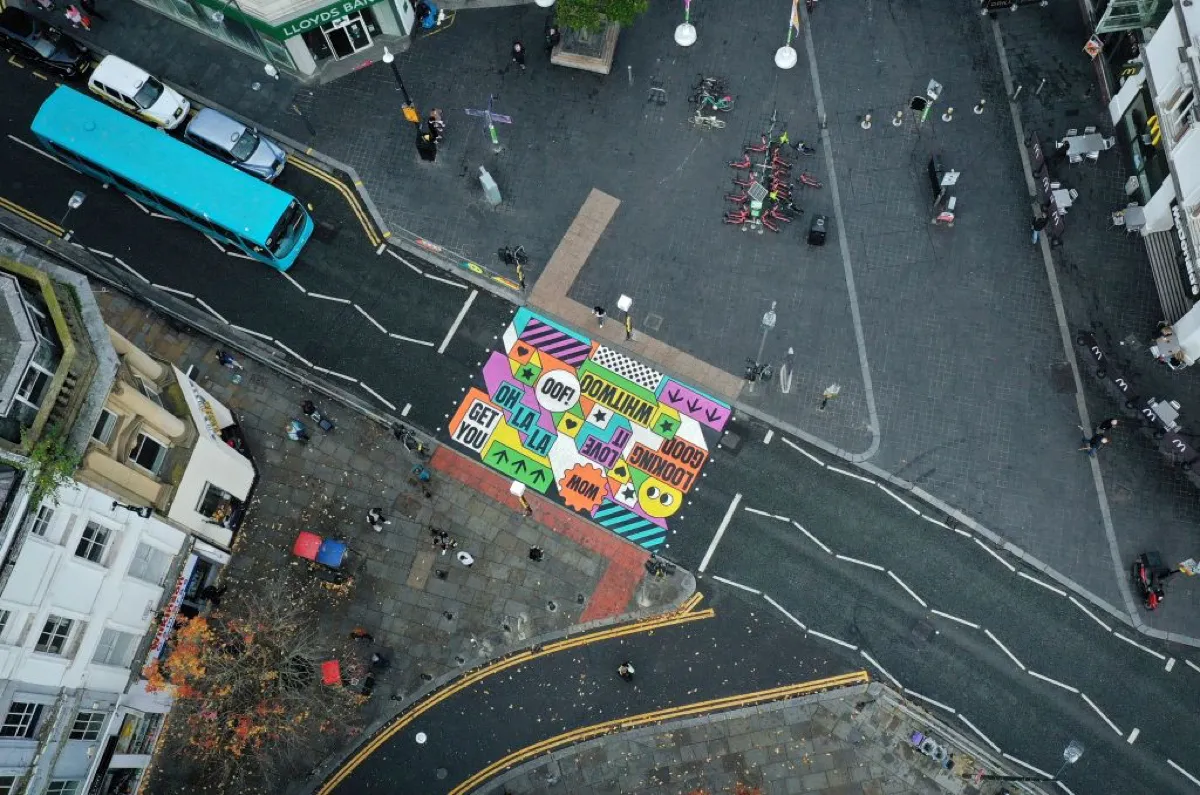The streets of London are notoriously colourful, and even more so now that some local authorities have joined the Asphalt Art Initiative, and decided to dress up pedestrian crossings in Pride colours or other equally bright designs. Some of these ‘colourful crossing’ being created by councils around the UK are created with more than just aesthetics in mind, focussing instead on preventing pedestrian casualties. These upgrades to existing crossings have been done in the name of behavioural science.
Two cities in England that have just finished a pilot experiment with the vibrant aesthetics are Liverpool and Hull. The former had 99 adult pedestrian deaths or serious injuries per 100,000 people in 2019 – making it the worst place in the UK that year – while in Hull 44 pedestrian casualties per 100,000 people were recorded.
“We call these colourful crossing ‘a nudge’ because in an urban environment pedestrians have a choice about where they cross the road,” says Dr Holly Hope-Smith, head of behavioural science at So-Mo, the consultancy working on the two trials. "We're trying to enhance a crossing that's already there so that people are more likely to use them.”
While Hope-Smith said that there had been little in terms of international research into colourful crossings, in 2004, research from Australian academics concluded that coloured surfaces on crossings had a positive effect on pedestrian safety with regards to the number of collisions and the severity of injuries sustained by pedestrians. They recommended that they be implemented in “busy” and “complex” pedestrian environments.
A year prior to this, an American study found that 41 per cent of survey respondents favoured coloured paving as a pedestrian. Other street designs ranked higher, though, with 83 per cent saying that a black-and-white striped crossing influenced their decision to cross the road at a specific location, and 74 per cent said that a pedestrian traffic light affected their crossing behaviour.
More recently, a 2017 report by Better Bankside about artworks implemented at crossings in London’s Southwark Street said: “[Our] interventions did make respondents more disposed to using the crossing, and 68 per cent told us that the artwork made them feel happier.”

Yet bright colours aren’t for everyone. Autistic people have raised concerns over the overwhelming nature of having several colours on a road, while guide dog owners have reported their assistance dogs being confused by the new road designs.
“Colour crossings can be really disorientating for people with low vision and their guide dogs,” says Dr Amy Kavanagh, a blind activist and campaigner. “I find some of these crossings physically painful and so disorientating I become dizzy. They have caused my guide dog confusion and even distress."
According to analysis from Dr Rachel Aldred from the University of Westminster that used date from 2007 to 2015, disabled people are five times more likely to be injured by a motor vehicle compared to non-disabled people. It means that there were 22 injuries reported amongst disabled pedestrians per 1 million miles walked, as opposed to 4.8 for non-disabled people.
In September 2021, a coalition made up of charities such as The Alzheimer’s Society, RNIB and Scope published an open letter to the Mayor of London, Sadiq Khan, raising concerns around the safety and accessibility of the Asphalt Art Initiative, which is part of Khan’s Let’s Do London campaign to encourage domestic tourism to the city.
Read more fromReality Check:
- Facebook Glasses: A law expert explains why they blur the lines around right to privacy
- Are we becoming more narcissistic?
- Perineum sunning and coffee enemas: Why are celebrities seemingly obsessed with wellness fads?
“The project demonstrates exactly what happens when meaningful engagement does not take place: it sadly results in schemes that are neither accessible nor inclusive,” the letter reads, citing issues with people with learning disabilities struggling to interpret artwork as crossings and those with dementia having ‘misperceptions’ around them.
Khan later responded to confirm that he has asked Transport for London (TfL) to “introduce a temporary pause” on colourful crossings. The decision was made “in light of the growing concern” about their impact on disabled people, and new TfL research. The Mayor added that new guidance on colourful crossings would be developed over the next year in consultation with organisations representing disabled people.
The conflicting needs of different people has sparked another conversation about the most inclusive solution. How can bright and colourful crossings be created in a way which cuts pedestrian casualties, without creating a whole new issue which puts disabled people at risk?
“These crossings are placed to enhance existing pedestrian crossings,” Hope-Smith says. “All the cues that are there for impaired road users remain – the touch sensors, the audio cue for when the crossing is on – we haven’t touched them.”
In the case of the Liverpool and Hull pilot, the trial ran until the end of October 2021 and the data is now being transferred to an independent company for analysis. The findings, Hope-Smith says, should be done by the end of the year.
- Visit the BBC's Reality Check website at bit.ly/reality_check_ or follow them on Twitter@BBCRealityCheck